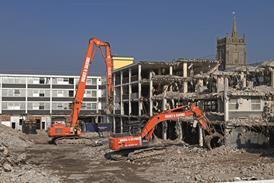There’s no chance of meeting demand for homes by prioritising large sites, despite political consensus, says Chris Tinker of Crest Nicholson

For the first time in my career there is agreement across all three main political parties that more houses are required. Mark Carney, governor of the Bank of England, faced with a plethora of calls to cool the potentially overheating housing market, also states that the only long-term solution to housing price inflation is the delivery of more homes, thereby addressing the supply and demand imbalance.
The latest estimates of housing demand between 2011 and 2031 in England confirm that an additional 243,000 homes are required per annum. Despite a positive sales environment the industry is delivering at just over half this level. So the question has to be asked whether, without a return to major public housing delivery – which is unlikely – we can achieve the levels of housebuilding required to meet assessed housing need?
In their recent trading updates all the major housebuilders have reported increases in the number of open market sales per outlet week (SPOW). They range from 0.65 to circa 0.8 SPOW. These are at the upper end of long term statistics which, in buoyant times, average circa 0.7 SPOW. If we assume on average that 25% of the 243,000 homes would be pre sold into the affordable housing market, then circa 182,000 homes p.a. will need to be delivered for open market sale and rent. This is unprecedented and, at 0.7 SPOW, would require the industry to be selling off 5,000 outlets; roughly twice the number it is currently selling. HBF statistics show that while the sales rate per site has increased in recent months, the industry’s attempts to open more outlets are proving challenging.
Planning is frequently identified by many in the industry as the primary constraint upon housing supply (an adequate supply of implementable permissioned land being the lifeblood of the industry). Planning consents for housing in 2013 were up 24% from 140,555 to 174,471 plots, suggesting that the NPPF is beginning to free up the system. However, three underlying factors mean that this statistic needs treating with some caution.
If we are to double delivery we need to focus on how to increase the number of permitted outlets and not just the number of permitted dwellings.
First, while consents in the Midlands increased 59%, they only increased 18% in Southern England where a significant proportion of housing need is being generated. Secondly, while the number of plots is increasing, the number of sites is not. This is primarily because the average size of sites permitted in recent years has increased. Finally, many of these consents are outline in nature, therefore require reserved matters consents and conditions to be cleared before delivery can commence.
If we are to double delivery we need to focus on how to increase the number of permitted outlets and not just the number of permitted dwellings. I suspect that the reason that the average size of site has increased in recent years is that Local Planning Authorities and developers, faced with widespread opposition to new housing, prefer a concentrated approach to consultation and planning rather than a dispersed strategy which risks re-running debilitating arguments across the whole of an administrative area.
In addition, larger sites are frequently able to mitigate their impacts in a more comprehensive way, whereas smaller sites can lead to a more piecemeal approach. In the absence of much public sector investment in social and physical infrastructure, the larger sites, which can address some of the infrastructure deficit, are easier to explain and justify.
It is the fact that a higher proportion of larger sites have been consented that leads some to argue that the industry is guilty of land banking. Given that there is a finite level of absorption that any local housing market can sustain, larger sites do mean that a proportion of the site cannot be delivered at any given point in time, while an equivalent number of homes on several sites across a number of towns or villages would lead to a faster delivery rate.
It is clear that if housing supply is to increase, and if small to medium sized housebuilders are to be encouraged back into the market, then the planning system will need to deliver consents on large and small sites alike. With this in mind it is important that Local Planning Authorities, having properly assessed housing need in their area, do not put all their emphasis onto a small number of large strategic sites, but that they balance this with a range of sites across many geographic areas and markets. That way, the delivery risks will be minimised and the full range of the industry’s delivery partners will be able to contribute fully.
Chris Tinker is executive board director and regeneration chairman at Crest Nicholson


























No comments yet